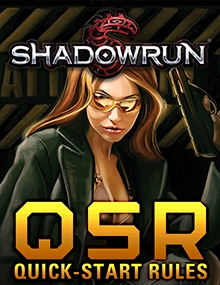Shadowrun 5th Edition – The Final Say (Part 4)
By Aaron T. Huss
Purchase the Shadowrun 5th Edition Quick-Start Rules here
 Welcome to Part 4 of the Featured Product series for Shadowrun (5th Edition) published by Catalyst Game Labs. Part 4, The Final Say, wraps up the delve into Shadowrun with some final thoughts on what I think.
Welcome to Part 4 of the Featured Product series for Shadowrun (5th Edition) published by Catalyst Game Labs. Part 4, The Final Say, wraps up the delve into Shadowrun with some final thoughts on what I think.
HOW MUCH?
Shadowrun is a lot to take in. It’s not that it’s just a game of cyberpunk; it’s not that it’s just a game of fantasy-infused sci-fi. It’s that Shadowrun is both of these and really a lot more. If you approach Shadowrun for the very first time, all of the options at your disposal can become quite overwhelming. You have to not only learn the core mechanics (which are quite simple), you also have to learn about and understand all the different situations Shadowrun attempts to compensate for (i.e. what modifiers are applied to your dice pool and when). You then need to have a good understanding of the setting because there are a lot of mechanics tied to the setting and don’t make as much sense without the two blending together. Then you have to learn about the matrix as it’s an integral part of the setting and the mechanics. Throw in fantasy races, technology, magic, horrors, megacorporations, and a whole lot more, and you’re bound to get flustered.
This doesn’t mean you can’t or shouldn’t do it. This just means you should be aware of what you’re coming into before you fully immerse yourself. Shadowrun is a hefty book, system, and setting. It’s had a lot of years to grow and become a thing of cyberpunk awesomeness, and it does that quite well. It’s just very bulky and those used to looser, faster systems and settings will not find the same here.
With that being said, I have one suggestion: point these people toward the Shadowrun 5th Edition Quick-start Rules. Why? Because you get a taste of all that Shadowrun goodness without having to really immerse yourself in the massive tome that is the core rulebook and the large number of options that come with it. Shadowrun is a game about options and the incredible things you can do with those options. To keep things simple for the newbies, reduce the number of options and keep things simple – thus the QSR. Once they get into the game, and the setting (both are equally important), then point them to the core rulebook and work with them to get through all that content.
Granted, the sticker price of the core rulebook is a bit high, but Shadowrun is one of those games where there is so much to it, you really need the core rulebook as a player to fully understand it (and you need to read it). There are many systems and settings out there where the GM can pick-up the core rulebook or setting guide and only give the players the tools they need to build characters. From there, learning and understanding the system and setting can easily be done during game-play. For Shadowrun, I don’t see that happening. There’s just too much there, but this is a good thing. It’s a very rich setting and a very powerful system (without bloating and complexity). Both of them set out what they want to do with a flair of efficiency. But then, when you have many years behind you, one would expect efficiency.
JUST OPINIONS
It’s extremely difficult to make comparisons to Shadowrun and any other system or setting out there. Yes there are other dice pool systems, including d6 dice pool systems; yes there are other cyberpunk settings out there. However, I can’t think of any that have such a rich setting history and a system that is tied in so directly to that setting. You can probably get the same shadowrunning, espionage-like, high-tech missions like that found in Shadowrun, but you probably won’t find them with such an interesting take on cyberpunk.
I’ll admit, I’m not a big fan of throwing fantasy races into cyberpunk with a setting history revolving mostly around humans. In sci-fi settings, I like to think of fantasy races as alien races and not something integral to the human society. Otherwise it feels more like fantasy and not sci-fi. However, after reading through this book, the fantasy races are a part of Shadowrun’s canon, but are by no means an ultimate requirement for game-play. You can run a team of only humans and interact with mostly humans keeping the fantasy races as adversaries or an opposing team of shadowrunners. You can weave as much fantasy within as you’d like because it’s not a requirement for the system to work. This goes back to my discussion on game balance. The characters feel quite balanced throughout and there’s nothing that keeps the players from ultimately choosing the group template they want without worrying about what archetype they might be missing and what fantasy race fits best with that archetype.
To me, this is one of the mechanically attractive features of Shadowrun – the ability to control the amount of fantasy and sci-fi without breaking the system. You may make parts of the setting disconnected, but that’s not a big deal. Simply move your team to a different place where the “scene” looks a little different. It is thus that when I look at Shadowrun as a whole, I really like the setting and the system. I’m not thrilled with all the possible modifiers and a couple of the finicky bits and pieces of the system, but those are just personal opinions and don’t reflect the design of the mechanics.
If you are interested in fantasy cyberpunk or at least cyberpunk with a lot of possibilities, Shadowrun is a perfect starting point. If the setting and system are overwhelming at first, start with the Quick-start Rules and go from there.


